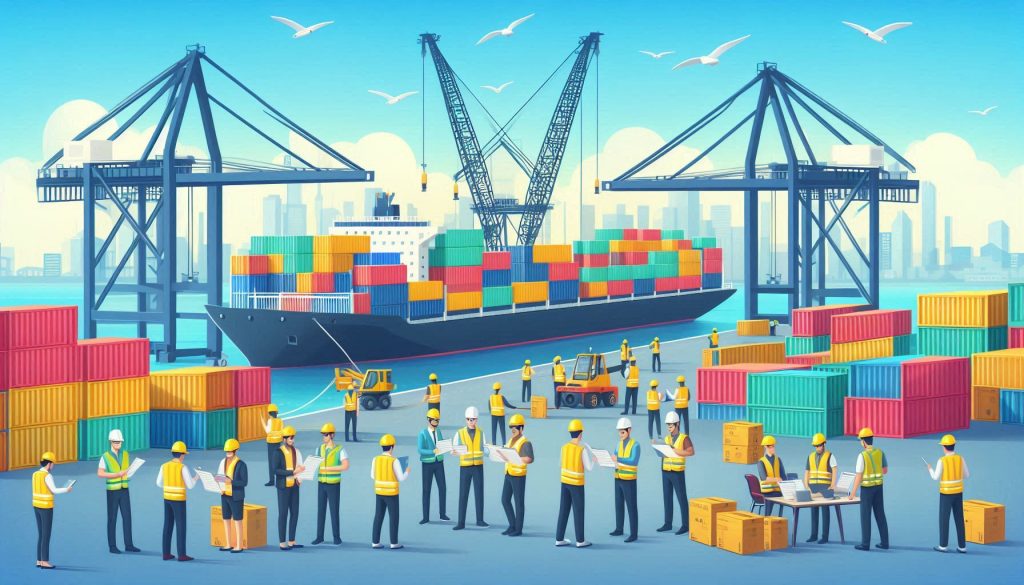International Business II – Complete Guide for Class 11 Business Studies Chapter 12
Our learning resources for Class 11th Business Studies Chapter 12 – International Business II are designed to ensure that you grasp this concept with clarity and perfection. Whether you’re studying for an upcoming exam or strengthening your concepts, our engaging animated videos, practice questions, and notes offer you the best of integrated learning with interesting explanations and examples. In the previous chapter i.e International
Foreign trade is an essential component of the global economy, involving the movement of goods across international borders and the use of foreign exchange. Engaging in the chapter International Business II requires adherence to numerous formalities before goods can leave the boundaries of one country and enter another. But how exactly is international business different from domestic business? Let’s delve into the specifics of class 11 Business Studies Chapter 12 International Business II.
Export-Import Procedures and Documentation
When it comes to international trade II, this chapter suggests that the procedures for importing and exporting goods can vary significantly from one country to another, influenced by statutory requirements and prevailing trade practices. It’s noteworthy that, in most countries, import-export trade is tightly regulated by the government. Here, we’ll discuss the procedures followed in India.
Export Procedure

As per the chapter International Business II, While embarking on an export transaction involves several steps. Let’s walk through a typical export procedure:
- Receipt of Enquiry and Sending Quotations: Prospective buyers send inquiries to various exporters regarding prices, qualities, and terms. Exporters respond with quotations in the form of a “Proforma Invoice,” detailing all relevant product information.
- Receipt of Order or Indent: After reviewing the Proforma Invoice, buyers place orders known as “Indents,” specifying goods descriptions, prices, delivery terms, and more.
- Assessing Importer’s Creditworthiness and Securing a Guarantee for Payments: Exporters often require a “Letter of Credit” from importers, ensuring payment through the importer’s bank.
- Obtaining Export Licence: Exporters must secure an export license, which involves obtaining an IEC (Export-Import Code) number and possibly an RCMC (Registration cum Membership Certificate).
- Obtaining Pre-shipment Finance: Exporters arrange financing for raw materials, processing, packaging, and transportation of goods to the port.
- Production or Procurement of Goods: The exporter either manufactures or procures the goods as per the importer’s specifications.
- Pre-shipment Inspection: Goods undergo inspection to ensure compliance with quality standards, leading to the issuance of an inspection certificate.
- Excise Clearance: Exporters may apply for excise duty exemption or drawback.
- Obtaining Certificate of Origin: This certificate, often required for tariff concessions, confirms the goods’ origin.
- Reservation of Shipping Space: Exporters book space with shipping companies, which issue shipping orders.
- Packing, Marking, and Forwarding: Goods are packed, marked with relevant details, and forwarded.
- Insurance of Goods: Exporters insure goods against risks during transit.
- Customs Clearance: Exporters prepare and submit shipping bills and other documents for customs clearance.
- Getting Mate’s Receipt: After loading, the ship’s captain issues a mate’s receipt.
- Payment of Freight and Issuance of Bill of Lading: Exporters pay freight and receive the bill of lading from the shipping company.
- Preparation of Invoice: Invoices detail the quantity of goods and amounts payable.
- Securing Payment: Exporters send necessary documents to importers for payment, either against sight or acceptance.
Now that we’ve covered the export procedures, let’s turn our attention to the import procedures, which involve several key steps.
Import Procedure

As per the chapter International Business II, the import procedure involves-
- Trade Enquiry: Importers gather information on potential exporters and send trade inquiry forms to request details.
- Procurement of Import Licence: Depending on the product, importers may need to obtain an import license and register with the DGFT (Director General Foreign Trade).
- Obtaining Foreign Exchange: Importers apply for foreign exchange from an authorized bank.
- Placing Order: Importers place detailed import orders specifying all relevant terms.
- Obtaining Letter of Credit: Importers secure a letter of credit to guarantee payment.
- Arranging for Finance: Importers arrange the necessary funds to avoid penalties.
- Receipt of Shipment Advice: Exporters send shipment advice with all relevant details post-shipment.
- Retirement of Import Documents: Importers accept the bill of exchange and retire documents from the bank.
- Arrival of Goods: The dock officer is informed upon the goods’ arrival, and the import general manifest is issued.
- Custom Clearance and Release of Goods: Importers prepare a bill of entry, pay duties, and receive the release order after customs clearance.
With a clear understanding of the import procedures, let’s explore the various foreign trade promotion measures and schemes available to support international business.
Foreign Trade Promotion Measures and Schemes
As per the chapter International Business II, to promote international trade, several measures and schemes are in place. Here are some of the major ones:
- Duty Drawback Scheme: Import duties on inputs used for export production are refunded.
- Export Manufacturing Under Bond Scheme: Manufacturers can be exempted from paying excise and other duties by committing to export all produced goods.
- Advance Licence Scheme: Exporters are allowed a duty-free supply of inputs for export production.
- Export Promotion Capital Goods Scheme (EPCG): This scheme encourages the import of capital goods for export production by offering concessional import duty rates.
- Recognition of Export Firms: Firms achieving prescribed export performance are recognized as Export Houses, Trading Houses, or Star Trading Houses.
- Export of Services: Various categories of service export houses are recognized to boost the export of services.
- Export Finance: Pre-shipment and post-shipment finance are available to support export activities.
- Export Processing Zones (EPZs): EPZs offer infrastructural facilities and duty exemptions to promote export production.
With these promotional measures in place, exporters can effectively compete in the international market. Now, next in the chapter International Business II, let’s look at the organizational support provided to facilitate foreign trade.
Organizational Support
As per the chapter International Business II, the Indian government has established several institutions to support foreign trade. Some of the key institutions include:
- Department of Commerce: The apex body responsible for framing policies and plans for foreign trade.
- Export Promotion Councils (EPCs): Non-profit organizations that promote exports through various activities.
- Commodity Boards: These boards support the manufacturing and export of traditional commodities.
- Export Inspection Council (EIC): The apex body overseeing quality control and pre-shipment inspection of exports.
- Indian Institute of Foreign Trade (IIFT): An autonomous body providing training and research in international trade.
- Indian Institute of Packaging (IIP): Provides infrastructural support for packaging and testing needs.
With this organizational support, exporters are well-equipped to navigate the complexities of international trade. Next in the chapter International Business II, let’s examine the international trade institutions and trade agreements that play a vital role in global trade.
International Trade Institutions and Trade Agreements
In the chapter International Business II, there is a mention of several international institutions and agreements that facilitate global trade. Key among them are:
- World Bank: Provides financial assistance to middle-income and low-income countries for poverty alleviation.
- International Development Association (IDA): Offers concessional loans to the world’s poorest countries.
- International Finance Corporation (IFC): Supports private sector development in developing countries.
- International Monetary Fund (IMF): Promotes international monetary cooperation and financial stability.
- World Trade Organisation (WTO): Regulates international trade, ensuring smooth and free trade flows.
World Bank
The chapter International Business II also mentions the World Bank. This World Bank aims to fight poverty by providing financial and technical assistance to developing countries for various developmental projects, including infrastructure, education, and healthcare. The institution works through five financial arms:
- IBRD (International Bank for Reconstruction and Development)
- IDA (International Development Association)
- IFC (International Finance Corporation)
- MIGA (Multilateral Investment Guarantee Agency)
- ICSID (International Centre for Settlement of Investment Disputes)
International Monetary Fund (IMF)
The IMF’s primary goal is to ensure the stability of the international monetary system. It facilitates international trade, promotes exchange rate stability, and provides resources to member countries in need.
World Trade Organisation (WTO)
The WTO oversees global trade rules, aiming to reduce trade barriers and ensure smooth trade flows. It also settles trade disputes between member countries and provides a framework for negotiating trade agreements.
WTO Agreements
Further in International Trade II, we’ll talk about WTO agreements which are the legal ground rules for international commerce. They aim to help producers of goods and services, exporters, and importers conduct their business while allowing governments to meet social and environmental objectives.
- General Agreement on Tariffs and Trade (GATT): Focuses on reducing tariffs and trade barriers in goods.
- General Agreement on Trade in Services (GATS): Aims to create a credible and reliable system of international trade rules for services.
- Trade-Related Aspects of Intellectual Property Rights (TRIPS): Establishes minimum standards for the regulation by national governments of many forms of intellectual property.
- Trade-Related Investment Measures (TRIMS): Ensures that investment measures do not restrict or distort trade.
- Dispute Settlement Understanding (DSU): Provides a mechanism for settling disputes and ensuring compliance with WTO agreements.
These agreements are vital in maintaining a stable and predictable international trading system, ensuring that international business is conducted smoothly and fairly.
Conclusion
The chapter International Business II from class 11th Business Studies involves a complex array of procedures and regulations, but with the right knowledge and support, it can be a highly rewarding venture. By understanding the detailed processes for export and import, leveraging trade promotion measures, and tapping into organizational support, businesses can effectively navigate the international market. Additionally, international trade institutions and agreements play a crucial role in maintaining stability and fairness in global trade. Armed with this information, you’re now better equipped to delve into the world of international business.
Practice questions on Chapter 12 - International Business- II
Get your free Chapter 12 - International Business- II practice quiz of 20+ questions & detailed solutions
Practice Now








